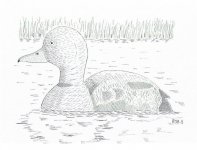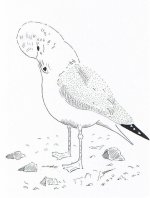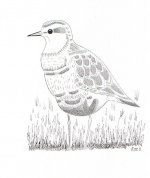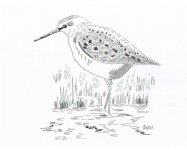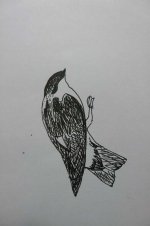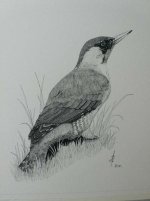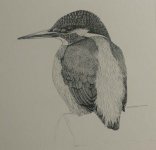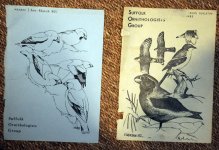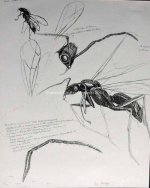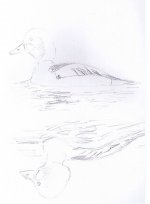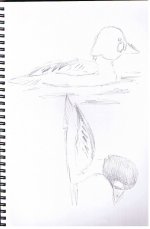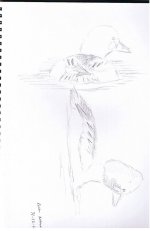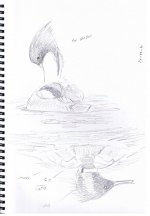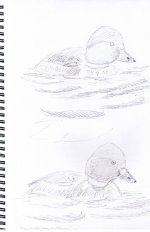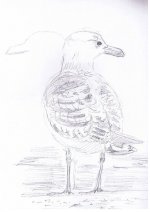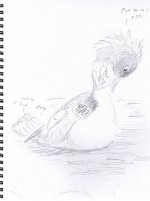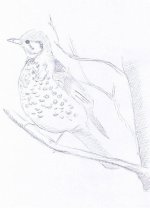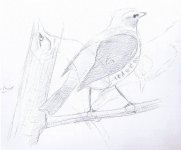-
Welcome to BirdForum, the internet's largest birding community with thousands of members from all over the world. The forums are dedicated to wild birds, birding, binoculars and equipment and all that goes with it.
Please register for an account to take part in the discussions in the forum, post your pictures in the gallery and more.
You are using an out of date browser. It may not display this or other websites correctly.
You should upgrade or use an alternative browser.
You should upgrade or use an alternative browser.
Recent sketches (2 Viewers)
- Thread starter RussB
- Start date
More options
Who Replied?RussB
Going for Gold
Thanks for the waxy comments, guys. All too brief a showing I'm afraid but all the better that I didn't have to walk around some housing estate being hit with a zillion questions!
For sometime I've admired good line drawings, but recently I've become a huge fan of what seems to sadly be a bit of a declining art form. Hours spent perusing over a load of old BBs someone kindly gave me got me appreciating just how good some b and w is. This stuff seems to get even better with age!
I know it's not everyone's cup of tea but I confess I love it and I've started searching it out all over! Inspired by the masterful renderings in some of the landmark books like 'The Breeding Atlas...' I've been experimenting with different lines, dots, hatches etc and asking lots of questions from some artists who's work I particularly like. Alan Harris informs me the decline of the line drawing can be attibuted to the advances in scanning and printing, with colour work now being as cheap as b and w to reproduce, and disconcertingly for me, some of these reproduction processes are not wholly suitable for line drawings. I'm forgetting it's no longer 1988!
Lots of accomplished artists (including several here at BF) could knock these out in their sleep at one bit, Im sure, but for me it's something different from the 2B!
Wanting to go down the illustrative route, I've done a few for a local bird report. Obviously these are not on the same planet as Harris, Leahy, Powell, Millington and the late Tuckeret al, and not in the same galaxy as Gillmor, Varela and the late Richardson, but I have to start somewhere - it's a whole new ball game!
Anway, Long-tailed Duck, Scaup, Ring-billed Gull and Dotterel and Wood Sand. Traced and worked up from field sketches.
As I don't really know what I'm doing here any advice would be most welcome! Don't be afraid to give em the once-over; they're mostly experimental. I know to draw quite a bit bigger for reproduction but that's about it!
Many thanks in advance
Russ
For sometime I've admired good line drawings, but recently I've become a huge fan of what seems to sadly be a bit of a declining art form. Hours spent perusing over a load of old BBs someone kindly gave me got me appreciating just how good some b and w is. This stuff seems to get even better with age!
I know it's not everyone's cup of tea but I confess I love it and I've started searching it out all over! Inspired by the masterful renderings in some of the landmark books like 'The Breeding Atlas...' I've been experimenting with different lines, dots, hatches etc and asking lots of questions from some artists who's work I particularly like. Alan Harris informs me the decline of the line drawing can be attibuted to the advances in scanning and printing, with colour work now being as cheap as b and w to reproduce, and disconcertingly for me, some of these reproduction processes are not wholly suitable for line drawings. I'm forgetting it's no longer 1988!
Lots of accomplished artists (including several here at BF) could knock these out in their sleep at one bit, Im sure, but for me it's something different from the 2B!
Wanting to go down the illustrative route, I've done a few for a local bird report. Obviously these are not on the same planet as Harris, Leahy, Powell, Millington and the late Tuckeret al, and not in the same galaxy as Gillmor, Varela and the late Richardson, but I have to start somewhere - it's a whole new ball game!
Anway, Long-tailed Duck, Scaup, Ring-billed Gull and Dotterel and Wood Sand. Traced and worked up from field sketches.
As I don't really know what I'm doing here any advice would be most welcome! Don't be afraid to give em the once-over; they're mostly experimental. I know to draw quite a bit bigger for reproduction but that's about it!
Many thanks in advance
Russ
Attachments
RussB
Going for Gold
Questions, questions!
These were scanned on my cheapo scanner in colour. It scans in b and w but it's rather grainy, and increasing the res makes no difference. I find the whole scanner/printing conundrum such a drag so I've given the publisher/editor the original to scan. I've no idea how they'll turn out! Can anyone give me a bit of guidance about this, please?
I've used a Rapidograph .18 for some of the drawing here, plus some slightly heavier cheapo Uni-pens (I'm amazed how long these last!) on normal cartridge paper. I've got some Bristol board but at the price it is I don't want to spoil it with cr@p drawings; does it actually give a neater line?
Has anyone any particular favourite pen? I've heard a few mentioned on here. I find the rapidograph needs to be held vertically to work; I prefer to hold something at an angle, like the disposable pens. The line's not as consistent, though.
Lastly, does anyone know of any good pen and ink book? I've got a couple cheap off amazon but they tend to be aimed at landscapers and architects. I wonder if there's anything out there with tips on how to render plumage?
Enough! Any line work (no washes - don't spoil it for me!) as examples from you guys would also be most welcome.
Cheers
Ps - fine spotted crake in that old BB, Ed!
These were scanned on my cheapo scanner in colour. It scans in b and w but it's rather grainy, and increasing the res makes no difference. I find the whole scanner/printing conundrum such a drag so I've given the publisher/editor the original to scan. I've no idea how they'll turn out! Can anyone give me a bit of guidance about this, please?
I've used a Rapidograph .18 for some of the drawing here, plus some slightly heavier cheapo Uni-pens (I'm amazed how long these last!) on normal cartridge paper. I've got some Bristol board but at the price it is I don't want to spoil it with cr@p drawings; does it actually give a neater line?
Has anyone any particular favourite pen? I've heard a few mentioned on here. I find the rapidograph needs to be held vertically to work; I prefer to hold something at an angle, like the disposable pens. The line's not as consistent, though.
Lastly, does anyone know of any good pen and ink book? I've got a couple cheap off amazon but they tend to be aimed at landscapers and architects. I wonder if there's anything out there with tips on how to render plumage?
Enough! Any line work (no washes - don't spoil it for me!) as examples from you guys would also be most welcome.
Cheers
Ps - fine spotted crake in that old BB, Ed!
rockfowl
Mark Andrews
I've become fanatic about line drawings, Mark. I want to jump in the Delorian and shoot off back to the 80's!
Ps
Have'nt forgot the lesson at Kao Yai!
Russ
Nothing wrong with being keen on the old black and whites Russ, in fact look at some of the turn of the century stuff, the last one!
I got fed up with unblocking rotoring, staedlers? etc but the very fine ones are useful sometimes, especially for eyes, when you need something to really ping. I was also forever breaking them, especially as like you I prefer to work on a slant. I started, and still do use a variety of disposables, any good stationer that tends to supply architects/designers etc should have a variety for you to test.
With regards the good 'pen and ink' book I don't know, but for this sort of work, I tend to favour hot pressed paper, which is tough stuff and the best ones allow you to scratch into it with a scalpel, for highlights and cleaning up/removing stuff. Again a good art suppliers should have a variety for you to feel. Tends to come in A1 size and you just cut it up.
Having said I didn't know, I just googled my favoured brand, cos I couldn't spell it - Schoellershammer and discovered they do this - http://www.thepapermillstore.com/product.php?productid=12133 Perhaps you could find a UK supplier if you like their paper or at least something similar.
I was looking at some rather nice B&W stuff yesterday on the Hungarian artists thread - http://www.gyulanagy.hu/images/grafika/index.html
Almost a year passed since Khao Yai, off again next week spoonering and then I guess China will be on its way for both of us!
Last edited:
ARTHUR BISHOP
Well-known member
hope you don't mind Russ But You did ask for some, although a lot of people on here can do better.
First one a quick sketch in RAR style using hash .
Other two are line and dot which I used to do . done with a map dip pen in calli ink because its truley waterproof. You can also water colour wash over it
First one a quick sketch in RAR style using hash .
Other two are line and dot which I used to do . done with a map dip pen in calli ink because its truley waterproof. You can also water colour wash over it
Attachments
Strandman
Well-known member
Questions, questions!
These were scanned on my cheapo scanner in colour. It scans in b and w but it's rather grainy, and increasing the res makes no difference. I find the whole scanner/printing conundrum such a drag so I've given the publisher/editor the original to scan. I've no idea how they'll turn out! Can anyone give me a bit of guidance about this, please?
Cheers
Ps - fine spotted crake in that old BB, Ed!
on scanning: me not expert, but I find what works best is to scan it really dark (like -20, -30) : that way you know you have got everything, nothing burned out or missed: then lighten it up just far enough on the computah
as for the spotted crake reference (if that's this Ed you mean) then truly you have the advantage of me...zero recollection...but its possible I suppose- I do like crakes
Last edited:
Woody
Well-known member
I was a studio manager back in the day, when linework was all done with Rotring rapidographs so I got very used to handling them in a formal way.
Letraset made a lineboard which we used to keep a consistent line, I always thought it was better than the famous Frisk CS10. The Letraset 5000 board had a silky smooth surface and a coating almost like a chalk which meant that, with a scalpel, it could be scraped away to sharpen lines or remove overdraw to make acurate corners
I also used it as a surface for illustration work, often working in 'line and dot' like Arthur's fine examples, tedious but effective.
Another really useful surface was acrylic drafting film. It looks opaque but acts like tracing paper which was useful because you could work up a pencil drawing then trace over it with Rotring pens on the film to produce a tidy black and white drawing.
If I went back to black and white now I'd probably use Edding 1800's because Rotring pens can be a pain in the butt to maintain and they're bl**dy expensive! The Eddings do produce a consistent line, at least when they're new, but if you abuse them a bit they soften up and the line takes on a bit more character which is not a bad thing.
Whatever you use it's a tough discipline so I wish you the very best of British with it!
I did mention somewhere a while back about a pen that made a good line that could then have water added to make a wash and I promised to look it out. It was a Pilot fineline roller pen but I don't think they still make it unfortunately.
Sorry to go on a bit, I just hope some of it might be useful!
Mike
Letraset made a lineboard which we used to keep a consistent line, I always thought it was better than the famous Frisk CS10. The Letraset 5000 board had a silky smooth surface and a coating almost like a chalk which meant that, with a scalpel, it could be scraped away to sharpen lines or remove overdraw to make acurate corners
I also used it as a surface for illustration work, often working in 'line and dot' like Arthur's fine examples, tedious but effective.
Another really useful surface was acrylic drafting film. It looks opaque but acts like tracing paper which was useful because you could work up a pencil drawing then trace over it with Rotring pens on the film to produce a tidy black and white drawing.
If I went back to black and white now I'd probably use Edding 1800's because Rotring pens can be a pain in the butt to maintain and they're bl**dy expensive! The Eddings do produce a consistent line, at least when they're new, but if you abuse them a bit they soften up and the line takes on a bit more character which is not a bad thing.
Whatever you use it's a tough discipline so I wish you the very best of British with it!
I did mention somewhere a while back about a pen that made a good line that could then have water added to make a wash and I promised to look it out. It was a Pilot fineline roller pen but I don't think they still make it unfortunately.
Sorry to go on a bit, I just hope some of it might be useful!
Mike
solitaryVSong
Well-known member
Fascinating discussion on all of this. Best of luck with it. I did run across a pertinent quote, though maybe one you won't be happy to hear, a few weeks ago. I was reading about the great American bird artist Louis Agassiz Fuertes. He said that he stopped doing black and white early on when he realized what a strain it was on his eyes. He seemed to think that you had to strain your eyes much more to see in just values of black to white, at least that was my interpretation.
Strandman
Well-known member
one further thought based on the torment of trying to do black n whites with a scrachy dip pen waaaay back in time: I think its important to decide if you are:
1 in essence doing an outline drawing, with plumage features and dark n half-tone areas just hinted at
OR
2 doing a more shaded drawing, full of cross-hatch, tones and half-tones, plumage features (like Arthur's beauties above)
I've binned pretty much anything b&w I have done of old, but these two early 1980s scraps show some grappling with the problems:
--the Crossbill would have started as some outlines, then a bit of cross hatchy shading goes in, which begs for more: then f*ck it, might as well do the wing black, so we end up with a super-hatched black rhino in place of a crossbill
--whereas a year later I did the Hawfinches and thought I won't make that mistake again, will concentrate on mixing thick and thin lines with breaks, be ruthless about only filling in the features I was interested in
that's the problem with Rotrings etc. and other non-bendy pens [at least for me]: how to get get the outlines to vary in thickness and fade into breaks, unless you draw the lines and then fade them by cutting white scratches across them
1 in essence doing an outline drawing, with plumage features and dark n half-tone areas just hinted at
OR
2 doing a more shaded drawing, full of cross-hatch, tones and half-tones, plumage features (like Arthur's beauties above)
I've binned pretty much anything b&w I have done of old, but these two early 1980s scraps show some grappling with the problems:
--the Crossbill would have started as some outlines, then a bit of cross hatchy shading goes in, which begs for more: then f*ck it, might as well do the wing black, so we end up with a super-hatched black rhino in place of a crossbill
--whereas a year later I did the Hawfinches and thought I won't make that mistake again, will concentrate on mixing thick and thin lines with breaks, be ruthless about only filling in the features I was interested in
that's the problem with Rotrings etc. and other non-bendy pens [at least for me]: how to get get the outlines to vary in thickness and fade into breaks, unless you draw the lines and then fade them by cutting white scratches across them
Attachments
solitaryVSong
Well-known member
Ca. 20 year old rapidograph drawing of winged ant, back when I had the patience to look through a microscope and spend hours drawing such things. As far as technique it was total improvisation.
I have to say I've never had the slightest urge to do this with birds. I think it was just too much like work, at least for me.
I have to say I've never had the slightest urge to do this with birds. I think it was just too much like work, at least for me.
Attachments
nickderry
C'est pas ma faute, je suis anglais.
line-drawing is damned hard, as Ed says, you must decide whether you're after an outline essence or a full range of tonal values (I LOVE those hawfinches!) I have to say I have never been a fan of hatching, I think that it's too easy to make it look like the bird is pieced together from old sacks and cloth (there are some who manage very well with cross-hatching though). I think that this sort of drawing is a lot of work, but the result looks as though it's been done quickly. Nowadays, I do my black and white work in black watercolour, I simply CAN'T do pen drawings to save my life! You're doing well with it, I think the trick is to 'design' the image thoroughly, there is little room for accidents.
buzzard12
Well-known member
Some stunning stuff here, Authurs Kingfisher and Ed's Hawfinches are fantastic.
Have done a lot of black and white work over the year's, indeed worked as an inker in a classical animation studio for five years, where I was trained to use mapping pen, where you dip into ink and apply line afterwards. A rather dated method and one which seems to have been forgotten. The simplest of penes, a basic holder which houses a stainless steel nib that holds a small amount of ink. The flexible nib means variation in line thickness can be achieved with practice, some thing that technical pens cannot do. Weight of line gives form and dimension and is a great aid to line drawing. Much of Eric Ennion's wonderful line drawings where done by this method, which lends itself well to additions of ink washes, or watercolour...
Have not used the method in years and should perhaps amend this soon...
Have done a lot of black and white work over the year's, indeed worked as an inker in a classical animation studio for five years, where I was trained to use mapping pen, where you dip into ink and apply line afterwards. A rather dated method and one which seems to have been forgotten. The simplest of penes, a basic holder which houses a stainless steel nib that holds a small amount of ink. The flexible nib means variation in line thickness can be achieved with practice, some thing that technical pens cannot do. Weight of line gives form and dimension and is a great aid to line drawing. Much of Eric Ennion's wonderful line drawings where done by this method, which lends itself well to additions of ink washes, or watercolour...
Have not used the method in years and should perhaps amend this soon...
timwootton
Well-known member
Have been following with interest - very useful discussion here. My only contribution, Russ, would be to give a fine sable an airing; a size 3 or 4 used with a black dipping ink (W&N etc) can give a broad variety of line quality which, I think, would suit your naturaistic approach to the subject.
Good luck.
Good luck.
RussB
Going for Gold
Well, gents, some very useful comments here. Most appreciated. Superb, and very different, examples of line work offered here from Arthur, Ed and Ken.
To try and keep as faithful as possible to the original sketch, I've traced the outline and as much of the shaded parts as I could, but ultimately something is lost. The Dotterel was redrawn as the original was done some time ago and was rather small so consequently it's not very good - I can do a lot better! Like I said, though, these are mainly experimental pieces.
I must say I favour the outline and dark and half tone as mentioned by Ed rather than the much more detailed style, although I still love Arthurs drawings - the kingfisher reminds me of a stunning Norman Arlott BB cover from many years ago.
I'd love to get the hand moving more, all the hatching is rather tedious, I must admit!
Sorry for sounding a bit dim but can someone please explain the 'dark and half-tone'. A lack of any art education I'm afraid, guys!
I do recognise the problem with rigid tips; Im having problems sussing out how to get tonal range from black to a highlighted area - are these flexible tipped pens still available, Alan?
I'll post a couple more very soon.
Once again, thanks for the guidance.
To try and keep as faithful as possible to the original sketch, I've traced the outline and as much of the shaded parts as I could, but ultimately something is lost. The Dotterel was redrawn as the original was done some time ago and was rather small so consequently it's not very good - I can do a lot better! Like I said, though, these are mainly experimental pieces.
I must say I favour the outline and dark and half tone as mentioned by Ed rather than the much more detailed style, although I still love Arthurs drawings - the kingfisher reminds me of a stunning Norman Arlott BB cover from many years ago.
I'd love to get the hand moving more, all the hatching is rather tedious, I must admit!
Sorry for sounding a bit dim but can someone please explain the 'dark and half-tone'. A lack of any art education I'm afraid, guys!
I do recognise the problem with rigid tips; Im having problems sussing out how to get tonal range from black to a highlighted area - are these flexible tipped pens still available, Alan?
I'll post a couple more very soon.
Once again, thanks for the guidance.
RussB
Going for Gold
Some recent efforts from several hours spent along the River Calder and the adjacent 90% frozen wetlands. Goldeneye can be a bit wary and subsequently rather distant on some local waters, but the birds on the Calder were obviously desperate for food and thus giving stonking views. Did lots of sketches, these few being the most, ahem, better ones!
Rather more wary Red-breasted Merg; sketches of a bird typically swimming away and preening. 1st W Great-Black-back on ice. The more I look at gulls the more fascinated I become with their ever-changing head shapes and facial expressions. These don't seem to get easier, alas!
Red-breasted Merg again, this time preening on the bank and two passerine efforts from the bedroom window - Mistle Thrush and Fieldfare - so you know that I Know what some passerines do look like!
I'm not complaining but when you spend nearly all your birding time sketching gulls and wildfowl do you only become better at gulls and wildfowl? It may be naive of me but I'd like to think you don't. Is life drawing life drawing? Does one hit a 'plateau'? Birds in flight remain a great challenge, but then how do capture that preening action or that quickly probing wader? Wonderful stuff aint it!
Russ
Rather more wary Red-breasted Merg; sketches of a bird typically swimming away and preening. 1st W Great-Black-back on ice. The more I look at gulls the more fascinated I become with their ever-changing head shapes and facial expressions. These don't seem to get easier, alas!
Red-breasted Merg again, this time preening on the bank and two passerine efforts from the bedroom window - Mistle Thrush and Fieldfare - so you know that I Know what some passerines do look like!
I'm not complaining but when you spend nearly all your birding time sketching gulls and wildfowl do you only become better at gulls and wildfowl? It may be naive of me but I'd like to think you don't. Is life drawing life drawing? Does one hit a 'plateau'? Birds in flight remain a great challenge, but then how do capture that preening action or that quickly probing wader? Wonderful stuff aint it!
Russ
Attachments
nickderry
C'est pas ma faute, je suis anglais.
I hope you realise just how good these are! The goldeneye are phenomenal - a species I used to sketch often in the UK, but they are quite scarce in this region, I caught up with one last month and found it damned hard to get it right - it looked exactly like your sketches.
To answer your question, familiarity with certain types of birds does make it easier afterwards to draw them in ways that aren't necessarily helpful when drawing other species, knowing where the feather tracts lie on a gull may make it easier to see them and draw them when sketching gulls, but will be chuff all help when sketching a duck. However, justthe act of looking helps train the eye to see, so it certainly can help in observing new things. One danger is over-familiarity with a species. This often leads to resorting to a sort of short-hand for the species - so many of my wallcreepers are in the same positions and drawn the same way, I find it really hard to see and draw new positions. It's almost as though I don't look at them any more, just draw from old memories - this is a bad thing to be shunned! I must learn to draw birds as though I had never seen them before. Each time! This week I looked at blue tits with fresh eyes, and realised that a lot of my old sketches were completely off as regard the pattern - in other words, I just hadn't been looking hard enough.
To answer your question, familiarity with certain types of birds does make it easier afterwards to draw them in ways that aren't necessarily helpful when drawing other species, knowing where the feather tracts lie on a gull may make it easier to see them and draw them when sketching gulls, but will be chuff all help when sketching a duck. However, justthe act of looking helps train the eye to see, so it certainly can help in observing new things. One danger is over-familiarity with a species. This often leads to resorting to a sort of short-hand for the species - so many of my wallcreepers are in the same positions and drawn the same way, I find it really hard to see and draw new positions. It's almost as though I don't look at them any more, just draw from old memories - this is a bad thing to be shunned! I must learn to draw birds as though I had never seen them before. Each time! This week I looked at blue tits with fresh eyes, and realised that a lot of my old sketches were completely off as regard the pattern - in other words, I just hadn't been looking hard enough.
timwootton
Well-known member
A quick appreciative nod to these wonderful drawings. Quite superb, really.
Similar threads
- Replies
- 22
- Views
- 2K
Users who are viewing this thread
Total: 3 (members: 0, guests: 3)




